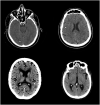Evaluating the Association of Calcified Neurocysticercosis and Mesial Temporal Lobe Epilepsy With Hippocampal Sclerosis in a Large Cohort of Patients With Epilepsy
- PMID: 35153977
- PMCID: PMC8830344
- DOI: 10.3389/fneur.2021.769356
Evaluating the Association of Calcified Neurocysticercosis and Mesial Temporal Lobe Epilepsy With Hippocampal Sclerosis in a Large Cohort of Patients With Epilepsy
Abstract
Background: Neurocysticercosis (NCC) is a parasitic infection of the central nervous system that has been associated with mesial temporal lobe epilepsy with hippocampal sclerosis (MTLE-HS). However, this association has not been completely established.
Objective: To evaluate the prevalence of calcified NCC (cNCC), its characteristics and a possible association between cNCC and MTLE-HS in a cohort of 731 patients with epilepsy.
Methods: We review clinical, EEG and neuroimaging findings of 731 patients with epilepsy. From these, 659 had CT-scans and 441 patients had complete neuroimaging with CT-scans and MRI. In these patients, we review the prevalence and characteristic of epilepsy in cNCC and in MTLE-HS patients.
Results: Forty-two (6.4%) of the 659 patients studied with CT-scans had cNCC. cNCC lesions were more frequent in women than in men (n = 33-78.6% vs. n = 09-21.4%, respectively; OR = 3.64;(95%CI = 1.71-7.69); p < 0.001). cNCC was more often in patients who developed epilepsy later in life, in older patients, in patients who had a longer history of epilepsy, and in those with a lower educational level. MTLE-HS was observed in 93 (21.1%) of 441 patients that had complete neuroimaging, and 25 (26.9%) of these 93 patients also had cNCC. Calcified NCC was observed in only 17 (4.9%) of the remaining 348 patients that had other types of epilepsy rather than MTLE-HS. Thus, in our cohort, cNCC was more frequently associated with MTLE-HS than with other forms of epilepsy, O.R. = 11.90;(95%CI = 6.10-23.26); p < 0.0001).
Conclusions: As expected, in some patients the epilepsy was directly related to cNCC lesional zone, although this was observed in a surprisingly lower number of patients. Also, cNCC lesions were observed in other forms of epilepsy, a finding that could occur only by chance, with epilepsy probably being not related to cNCC at all. In this cohort, cNCC was very commonly associated with MTLE-HS, an observation in agreement with the hypothesis that NCC can contribute to or directly cause MTLE-HS in many patients. Given the broad world prevalence of NCC and the relatively few studies in this field, our findings add more data suggesting a possible and intriguing frequent interplay between NCC and MTLE-HS, two of the most common causes of focal epilepsy worldwide.
Keywords: epileptogenesis; gender differences in epilepsy; hippocampal sclerosis; inflammation in epilepsy; initial precipitating injury (IPI); neurocysticercosis.
Copyright © 2022 Secchi, Brondani, Bragatti, Bizzi and Bianchin.
Conflict of interest statement
The authors declare that the research was conducted in the absence of any commercial or financial relationships that could be construed as a potential conflict of interest.
Figures




References
LinkOut - more resources
Full Text Sources
Research Materials

